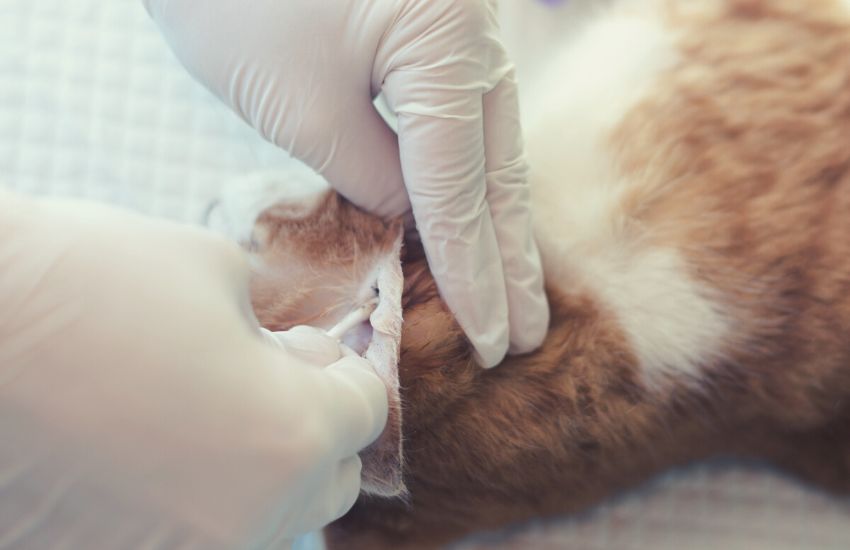shelter pets in need
Each order helps pets in need

Cats are pretty adept at caring for themselves, but even they can get injuries that affect their ears. Some ear problems in cats can occur naturally, while others are caused by trauma.
As a cat owner, you must be aware of any signs of ear injuries to ensure you can provide the necessary care and treatment to keep your feline friend healthy. Here we will look at five common cat ear injuries and infections.
Knowing the early warning signs can help pet owners address the problem, seek veterinary care, and prevent further damage or infections.
There are many reasons why cat ear infections and injuries happen. Sometimes, if your cat likes to scratch its ear too much, it can cut or wound itself. This can lead to an infection. Some parasites in your cat's ear can also cause infections if left untreated.
A cat's ears are also sensitive to environmental allergens and can cause an allergic reaction. In addition, cats with chronic illnesses such as diabetes or those undergoing long-term corticosteroid treatment are at a higher risk of developing ear infections.
Injuries can also occur from accidents or fights with other animals, resulting in cuts or bruises that can cause pain and infection. Regular cleaning and examining a cat's ears are essential to prevent diseases and catch injuries early.
Below are some of the ear problems common in cats. If your pet shows signs of ear disease, take your cat to a vet immediately to get the best treatment possible.
One of the most common ear issues or ear infections experienced by cats and kittens (especially if they're allowed outside or come into contact with other cats) is ear mite infestation. Outer ear infections in cats are called otitis externa.

Mites are tiny parasites that live in the ear canal. Lots of scratching and head shaking are common with ear mites.
You probably will also see a buildup of brown wax from your cat's ear flap to the inner part of the ear if your cat has contracted ear mites. Your vet can quickly diagnose mites and give ear drops to your cat's ears. It's also important to treat all animals in the house because mites can quickly spread to other cats.
Cat fights are a common cause of cat ear injuries because the ears are delicate and exposed. Bites, scratches, and tears can occur during fights. These wounds can become infected.
Your cat can also get blood blisters on the ears from fighting . . . and also from excessive scratching. These can lead to other ear infections, so seeing your vet for antibiotics for infected wounds is best.
Blood blisters should be drained. Left untreated, they can deform the ear over time. The best prevention for ear injuries is to neuter cats and keep them indoors to prevent fighting.
Cats can become deaf from old age, have ear infections, head injuries, and even when the ears become blocked with too much wax. It's also true that some cats are genetically predisposed to deafness.
The gene associated with white fur and blue eyes can also cause deterioration of the inner ear. See your vet if you suspect hearing loss in your cat. Bad infections can lead to permanent hearing loss.
Your cat's ears can become infected when a foreign body gets stuck in the ear or from fungus or bacteria. Your cat will scratch the ear, and you may see swelling, redness, and discharge.
Infections can be in the ear canal or go deeper into the inner part of the ear. Internal ear infections can lead to hearing loss, a tilted head, and even a loss of balance. See your vet for treatment, ranging from ear drops to oral antibiotics for more severe infections.
The ear area can be a common site of skin cancer in cats, especially those with light-colored fur who spend a lot of time out in the sun. Keeping your cat indoors will protect him from direct sun exposure and from getting an ear infection.
You can also apply pet sunscreen to your cat's ears. Growths and sores that do not heal can indicate skin cancer. See your vet to discuss treatment. Ears (along with paws and tails) can also be affected by frostbite. Keep your cat indoors during cold weather.
It is advisable to visit a veterinarian if your cat has chronic ear infections so the doctor can immediately provide treatment and the proper medication.
Regular cleaning and maintenance of the ears are essential to prevent common ear problems in cats. This can be done by wiping the inner ear flaps with a damp cloth or using ear drops recommended by a veterinarian.
It is also essential to check for signs of infections or parasites, such as ear mites, which can cause itchiness and inflammation in the ears. Avoid exposing your cat to excessive moisture or swimming, as this can increase the likelihood of ear infections. You can also consider getting a catio so your pet can safely roam outdoors.
A healthy diet and regular veterinary check-ups can help maintain overall health and prevent infections from spreading.
If your cat shows any signs of discomfort or ear problems, such as excessive scratching or shaking of the head, it is essential to seek veterinary care as soon as possible.

Signs of an ear injury or infection could include excessive scratching at the ear, shaking the head, and sensitivity or pain in the ear. Ear infections can have dire consequences if not treated properly.
Symptoms of a severe condition could include dark-colored ear discharge, ear swelling, and a bad smell. If you notice any of these signs, take your cat to the vet immediately.
A veterinarian can diagnose the problem and give your cat appropriate treatment. Generally, it's always a great idea to seek veterinary care if you notice your cat showing signs of pain or discomfort.
Can cat ear infections be prevented?
Yes, you can prevent cat ear infections. Follow our tips and regularly inspect your cat's ears to ensure it doesn't have mites or wounds that can be infected.
Healthy ears are light pink, with little to no visible earwax and no odor. You may detect a possible ear infection early by frequently testing and getting it treated before it worsens.
It is ideal if the vet either does the ear cleaning themself or shows you how to do it. Never put a cleaning tool inside the ear canal unless your veterinarian has told you to.
What is the most common cat ear infection?
The most common ear infection in cats is ear mites.
Are ear infections in cats contagious?
Ear infections in cats are generally not contagious to humans or other pets except those caused by parasites. Parasites like mites can be contagious to other cats, so if one cat is infected, it is best to consult a veterinarian for treatment options for all cats in the household.
Can cats get polyps in their ear canal?
Cats can sometimes get polyps or "growths" within their ear canal. Occasionally, they are non-cancerous. They may not result in an ear infection but can cause pain and discomfort for your cats. Consult your veterinarian if you notice your cats are experiencing discomfort.
What is otitis externa?
Otitis externa means outer ear infections.
What is otitis media?
It is middle ear infections or inflammations.
What happens if outer ear infections are not treated?
If outer ear infections are not treated, the ear infection can go to the middle ear, where it gets the term "otitis media." When it goes further from the middle ear to the inner ear, it gets termed "otitis interna." In severe cases, the inner ear and eardrum can get damaged or affected, leading to deafness.
Leave a comment